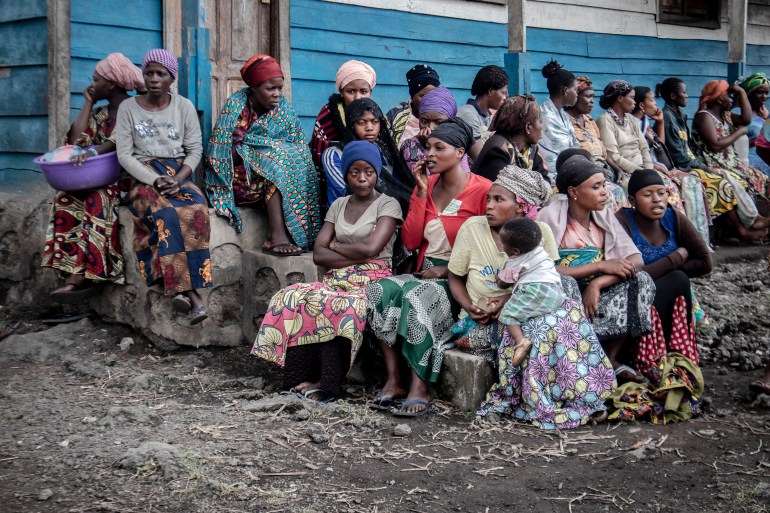More than 200 earthquakes since Saturday’s eruption have damaged buildings and streets in Goma, causing.
More than 20,000 people are homeless and 40 are still missing in the aftermath of a volcanic eruption in the eastern Democratic Republic of the Congo that killed dozens and continues to cause strong earthquakes in the nearby city of Goma, the United Nations has said.
Saturday’s eruption sent rivers of lava streaming down the hillside from Mount Nyiragongo, destroying hundreds of homes and forcing thousands to flee, but stopped 300 metres (984 feet) short of Goma airport, the main hub for aid operations in the east of DRC.
The lakeshore city of 1.5 million people lies about 12km (8 miles) from the volcano.
The ash cloud caused by the eruption has closed down airports in Goma and Bukavu, and is likely to cause respiratory diseases, the UN Office for Coordination of Humanitarian Affairs (OCHA) said in a statement on Wednesday.
People who fled their homes have lost valuable possessions including motorcycles that were either consumed by the lava flow or looted, OCHA said.
The death toll from the eruption rose to 32 on Tuesday.
More than 200 small and medium earthquakes have since caused cracks in buildings and streets in Goma.
The cracks, almost 60cm (2 feet) wide in some places, have caused panic among residents unsure if the danger has passed.
 Congolese riders are seen near a crack on the road caused by earthquakes near Goma, in the DRC [Djaffar al-Katanty/Reuters]
Congolese riders are seen near a crack on the road caused by earthquakes near Goma, in the DRC [Djaffar al-Katanty/Reuters]“Yesterday it was very small, here it is just opposite my house, but today it has widened,” Susanne Bigakura, 65, told Reuters news agency. “It’s scary. We fear it can collapse and our children can fall in.”“It scares me because those who saw the 2002 eruption told us that where a crack passes, it will be catastrophic. Now, when we see a fissure after a recent eruption, I’m worried that we are in danger,” said Valentin Kikuni, a welder.
Some of the fissures opened up on roads, hindering traffic.
Fearful of their homes collapsing, many people slept outside on mattresses, the luckier ones under mosquito nets.
Residents felt the tremors at regular intervals throughout the night, with two powerful shocks from Africa’s most active volcano triggering a widespread alarm and causing terrified people to run out of their homes.
The seismic monitoring agency RSM in neighbouring Rwanda, whose border runs close to Goma, said it had detected a 5.1 magnitude earthquake at 5:46am (3:46 GMT), followed by a 4.1 magnitude quake at 6:12am.
Authorities shut down the market, shops and several building sites as a precaution.
On Tuesday, at least four buildings partially collapsed in Goma, including a three-storey structure in which eight people were seriously injured, emergency workers said.
 Residents displaced by the Mount Nyiragongo volcanic eruption wait to register to receive some aid distributed by a local politician and businessman in Goma [Guerchom Ndebo/AFP]
Residents displaced by the Mount Nyiragongo volcanic eruption wait to register to receive some aid distributed by a local politician and businessman in Goma [Guerchom Ndebo/AFP]Local volcanologists have recorded hundreds of aftershocks since Nyiragongo roared back into life, including 119 on Monday alone, but say there is hope that the much-feared volcano will calm down.Government officials who visited Goma on Monday announced several relief measures including paying for victims’ funerals, supplying roofing material, food and medicines, as well as psychological counselling and emergency repairs of damaged infrastructure.
But residents remain jittery. Hundreds are sheltering in a Rwandan refugee camp, and many are continuing to flee there, according to the Rwandan emergency situations ministry.
Boats are ferrying hundreds of people from Goma to Bukavu, about 70km (43.5 miles) down the shore of Lake Kivu.
A 1.7km (1 mile) long river of lava that blocked the main road north from Goma is still too hot to be removed, OCHA said, preventing trade and aid deliveries to one of the most food-insecure places in Africa.
However, some work has begun on restoring the road, according to images on the government’s Twitter feed.
A so-called strato-volcano nearly 3,500 metres (11,500 feet) high, Nyiragongo straddles the East African Rift tectonic divide.
Its last major eruption, in 2002, killed nearly 100 people.



No comments:
Post a Comment
Note: only a member of this blog may post a comment.